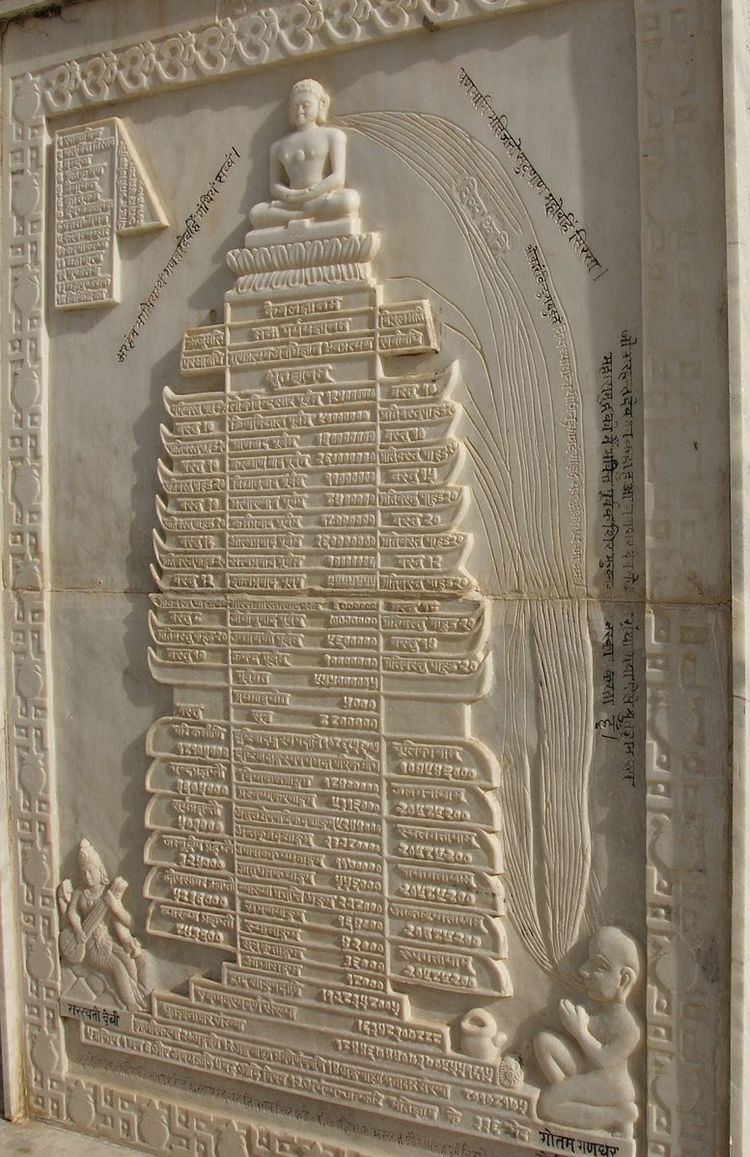 | ||
Agamas are original texts of Jainism based on the discourses of the tirthankara. The discourse delivered in a samavasarana (divine preaching hall) is called Śhrut Jnāna and comprises eleven angas and fourteen purvas. The discourse is recorded by Ganadharas (chief disciples), and is composed of twelve angas (departments). It is generally represented by a tree with twelve branches. This forms the basis of the Jaina Agamas or canons. These are believed to have originated from Rishabhanatha, the first tirthankara.
Contents
The earliest versions of Jain Agamas known were composed in Ardhamagadhi Prakrit language. Agama is a Sanskrit word which signifies the 'coming' of a body of doctrine by means of transmission through a lineage of authoritative teachers.
History
Gautamasvami is said to have compiled the most sacred canonical scriptures comprising twelve parts, also referred to as eleven Angas and fourteen Pūrvas, since the twelfth Anga comprises the fourteen Pūrvas. These scriptures are said to have contained the most comprehensive and accurate description of every branch of learning that one needs to know. The knowledge contained in these scriptures was transmitted orally by the teachers to their disciple saints Digambara sect of Jainism maintains that the Agamas were lost during the same famine that the purvas were lost in. According to the Digambaras, Āchārya Bhutabali was the last ascetic who had partial knowledge of the original canon. Later on, some learned Āchāryas started to restore, compile and put into written words the teachings of Lord Mahavira, that were the subject matter of Agamas. Āchārya Dharasen, in first century CE, guided two Āchāryas, Āchārya Pushpadant and Āchārya Bhutabali, to put these teachings in the written form. The two Āchāryas wrote, on palm leaves, Ṣaṭkhaṅḍāgama- among the oldest known Digambara Jaina texts. This was about 683 years after the nirvana of Mahavira.
While some authors date the composition of Jain Agamas starting from the 6th century BC, noted Indologist Hermann Jacobi holds that the composition of the Jaina siddhanta would fall somewhere about the end of the 4th or the beginning of the 3rd century BC. The general consensus amongst western scholars,like Ian Whicher and David Carpenter is that the earliest portions of Jain siddhanta were composed around the 4th or 3rd century BC. This may not be in agreement with Jain tradition according to which the agamic literature and the Purvas were passed from one heads of the order to his disciples for around 170 years after the nirvana of Mahavira. However, with time, it became difficult to keep the entire Jain literature committed to memory. In the 3rd century B.C., Chandragupta Maurya was the ruler of Magadha and Bhadrabahu, (the last knower of complete Jain agamas) was the head of Jain community. Predicting a 12 year long famine, Bhadrabahu went south to Karnataka with his adherents and Sthulabhadra, another Jain monk remained behind. During this time the knowledge of the doctrine was getting lost. A council was formed at Pataliputra where eleven scriptures called Angas were compiled and the remnant of fourteen purvas were written down in 12th Anga, Ditthivaya by the adherents of Sthulbhadra. Due to the twelve years of famine it was extremely difficult for the Jain ascetics to preserve the entire canonical literature. The Purvas or the ancient texts were already forgotten and lost after the famine. According to Svetambara tradition, the agamas were collected on the basis of collective memory of the ascetics in the first council of Pataliputra under the stewardship of Sthulibhadra in around to 463–367 BC.
In 453 or 466 CE that the Vallabhi council of the Svetambara Jain monks recompiled the Agamas and recorded them as written manuscripts under the leadership of Acharya Shraman Devardhigani along with other 500 Jain scholars. The existing Svetambara texts are based on the Vallabhi council texts. Digambaras reject the authority of the Agamas compiled at Valabhi.
Angas
The knowledge of Shruta-Jnana, may be of things which are contained in the Angas (Limbs or sacred Jain books) or of things outside the Angas.
The Agamas were composed of the following forty-six texts:
Jain literature
The digambaras maintain that original agamas were lost and knowledge of only one anga is available. The most authoritative Jain text accepted both by Digambara and Svetamberas is Tattvartha Sutra. It is the first Jain scripture written in the Sanskrit language. Other Sanskrit Jain literature includes śrāvakācāras such as the Ratnakaranda śrāvakācāra.
Digambaras group texts into four literary categories called 'exposition' (anuyoga). The 'first' (prathma) exposition contains Digambara versions of the Universal History; the 'calculation' (karana) exposition contains works on cosmology; the 'behaviour' (charana) exposition includes texts about proper behaviour for monks and lay people.
Languages of Aagams
The Jain literature includes both religious texts and books on generally secular topics such as sciences, history, and grammar. The Jains have used several languages at different times and in different regions of India. The earliest versions of Jain Agamas known were written in Ardhamagadhi Prakrit language.
Importance
For Jains, their scriptures represent the literal words of Mahāvīra and the other fordmakers only to the extent that the Agama is a series of beginning-less, endless and fixed truths, a tradition without any origin, human or divine, which in this world age has been channelled through Sudharma, the last of Mahavira's disciples to survive.
